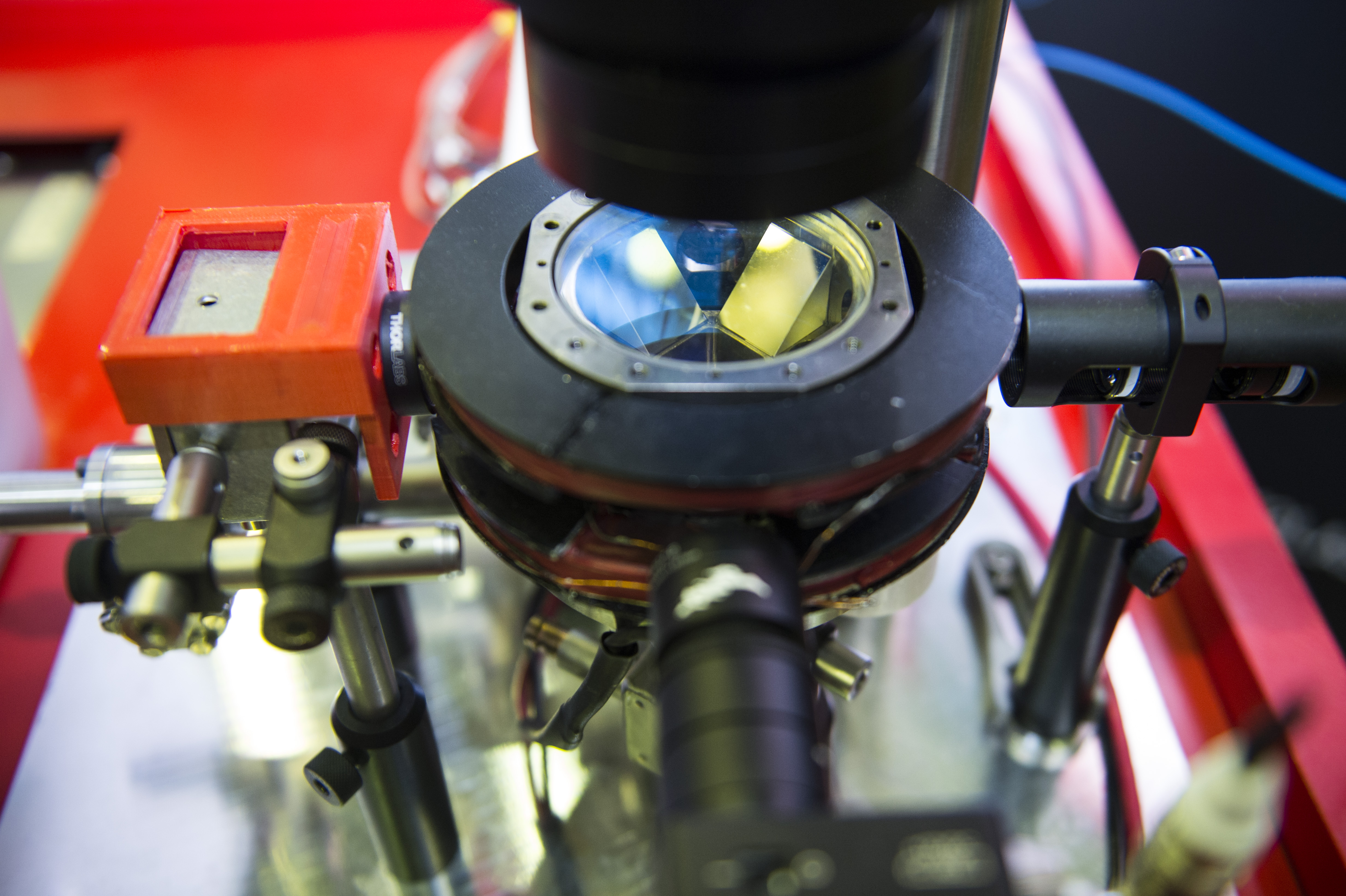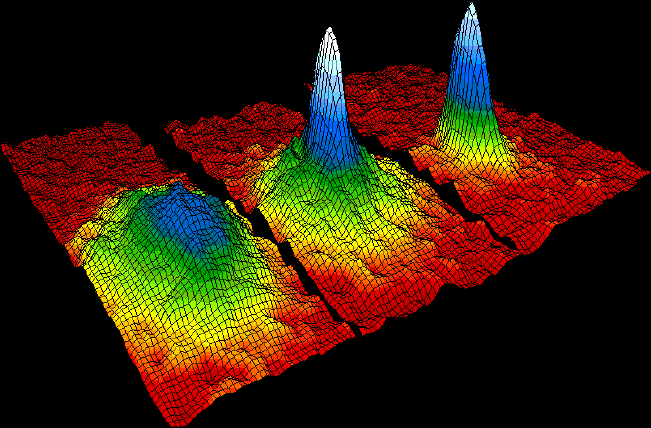|
Atom Laser
An atom laser is a coherent state of propagating atoms. They are created out of a Bose–Einstein condensate of atoms that are output coupled using various techniques. Much like an optical laser, an atom laser is a coherent beam that behaves like a wave. There has been some argument that the term "atom laser" is misleading. Indeed, "laser" stands for "Light Amplification by Stimulated Emission of Radiation" which is not particularly related to the physical object called an atom laser, and perhaps describes more accurately the Bose–Einstein condensate (BEC). The terminology most widely used in the community today is to distinguish between the BEC, typically obtained by evaporation in a conservative trap, from the atom laser itself, which is a propagating atomic wave obtained by extraction from a previously realized BEC. Some ongoing experimental research tries to obtain directly an atom laser from a "hot" beam of atoms without making a trapped BEC first. Introduction The first pu ... [...More Info...] [...Related Items...] OR: [Wikipedia] [Google] [Baidu] |
Coherent State
In physics, specifically in quantum mechanics, a coherent state is the specific quantum state of the quantum harmonic oscillator, often described as a state which has dynamics most closely resembling the oscillatory behavior of a classical harmonic oscillator. It was the first example of quantum dynamics when Erwin Schrödinger derived it in 1926, while searching for solutions of the Schrödinger equation that satisfy the correspondence principle. The quantum harmonic oscillator (and hence the coherent states) arise in the quantum theory of a wide range of physical systems.J.R. Klauder and B. Skagerstam, ''Coherent States'', World Scientific, Singapore, 1985. For instance, a coherent state describes the oscillating motion of a particle confined in a quadratic potential well (for an early reference, see e.g. Schiff's textbook). The coherent state describes a state in a system for which the ground-state wavepacket is displaced from the origin of the system. This state can be relate ... [...More Info...] [...Related Items...] OR: [Wikipedia] [Google] [Baidu] |
Immanuel Bloch
Immanuel Bloch (born 16 November 1972, Fulda) is a German experimental physicist. His research is focused on the investigation of quantum many-body systems using ultracold atomic and molecular quantum gases. Bloch is known for his work on atoms in artificial crystals of light, optical lattices, especially the first realization of a quantum phase transition from a weakly interacting superfluid to a strongly interacting Mott insulating state of matter. Career Bloch studied physics at the University of Bonn in 1995, followed by a one-year research visit to Stanford University. He obtained his PhD in 2000 working under Theodor W. Hänsch at the Ludwig-Maximilian's University in Munich. The thesis title was ''Atomlaser und Phasenkohärenz atomarer Bose-Einstein-Kondensate''. As a junior group leader, he continued in Munich and started his work on ultracold quantum gases in optical lattices. In 2003, he moved to a full professor position in experimental physics at the University of ... [...More Info...] [...Related Items...] OR: [Wikipedia] [Google] [Baidu] |
List Of Laser Articles
This is a list of laser topics. A * 3D printing, additive manufacturing * Abnormal reflection * Above-threshold ionization * Absorption spectroscopy * Accelerator physics * Acoustic microscopy * Acousto-optic deflector * Acousto-optic modulator * Acousto-optical spectrometer * Acousto-optics * Active laser medium * Active optics * Advanced Precision Kill Weapon System * Advanced Tactical Laser * Afocal system * Airborne laser * Airborne wind turbine * Airy beam * ALKA * All gas-phase iodine laser * Ambient ionization * Amplified spontaneous emission * Analytical chemistry * Aneutronic fusion * Antiproton Decelerator * Apache Arrowhead * Apache Point Observatory Lunar Laser-ranging Operation * Arago spot * Argon fluoride laser * Argus laser * Asterix IV laser * Astrophysical maser * Atmospheric-pressure laser ionization * Atom interferometer * Atom laser * Atom probe * Atomic clock * Atomic coherence * Atomic fountain * Atomic line filter * Atomic ratio ... [...More Info...] [...Related Items...] OR: [Wikipedia] [Google] [Baidu] |
Atom Interferometry
An atom interferometer is an interferometer which uses the wave character of atoms. Similar to optical interferometers, atom interferometers measure the difference in phase between atomic matter waves along different paths. Atom interferometers have many uses in fundamental physics including measurements of the gravitational constant, the fine-structure constant, the universality of free fall, and have been proposed as a method to detect gravitational waves. They also have applied uses as accelerometers, rotation sensors, and gravity gradiometers. Overview Interferometry inherently depends on the wave nature of the object. As pointed out by de Broglie in his PhD thesis, particles, including atoms, can behave like waves (the so-called wave–particle duality, according to the general framework of quantum mechanics). More and more high precision experiments now employ atom interferometers due to their short de Broglie wavelength. Some experiments are now even using molecules to o ... [...More Info...] [...Related Items...] OR: [Wikipedia] [Google] [Baidu] |
De Broglie Wavelength
Matter waves are a central part of the theory of quantum mechanics, being an example of wave–particle duality. All matter exhibits wave-like behavior. For example, a beam of electrons can be diffracted just like a beam of light or a water wave. In most cases, however, the wavelength is too small to have a practical impact on day-to-day activities. The concept that matter behaves like a wave was proposed by French physicist Louis de Broglie () in 1924. It is also referred to as the ''de Broglie hypothesis''. Matter waves are referred to as ''de Broglie waves''. The ''de Broglie wavelength'' is the wavelength, , associated with a massive particle (i.e., a particle with mass, as opposed to a massless particle) and is related to its momentum, , through the Planck constant, : : \lambda = \frac=\frac. Wave-like behavior of matter was first experimentally demonstrated by George Paget Thomson's thin metal diffraction experiment, and independently in the Davisson–Germer experiment ... [...More Info...] [...Related Items...] OR: [Wikipedia] [Google] [Baidu] |
Holography
Holography is a technique that enables a wavefront to be recorded and later re-constructed. Holography is best known as a method of generating real three-dimensional images, but it also has a wide range of other applications. In principle, it is possible to make a hologram for any type of wave. A hologram is made by superimposing a second wavefront (normally called the reference beam) on the wavefront of interest, thereby generating an interference pattern which is recorded on a physical medium. When only the second wavefront illuminates the interference pattern, it is diffracted to recreate the original wavefront. Holograms can also be computer-generated by modelling the two wavefronts and adding them together digitally. The resulting digital image is then printed onto a suitable mask or film and illuminated by a suitable source to reconstruct the wavefront of interest. Overview and history The Hungarian- British physicist Dennis Gabor (in Hungarian: ''Gábor Dén ... [...More Info...] [...Related Items...] OR: [Wikipedia] [Google] [Baidu] |
Tilman Esslinger
Tilman Esslinger is a German experimental physicist. He is Professor at ETH Zurich, Switzerland, and works in the field of ultracold quantum gases and optical lattices. Biography Tilman Esslinger received his PhD in physics from the University of Munich and the Max Planck Institute of Quantum Optics, Germany, in 1995. In his doctoral research he worked under the supervision of Theodor Hänsch on subrecoil laser cooling and optical lattices. He then build up his own group in Hänsch’s lab and conducted pioneering work on atom lasers, observed long-range phase coherence in a Bose–Einstein condensate, and realized the superfluid to Mott-insulator transition with a Bose gas in an optical lattice. Following his habilitation, Esslinger was in October 2001 appointed full professor at ETH Zurich, Switzerland, where he pioneered one-dimensional atomic quantum gases, Fermi–Hubbard models with atoms, a quantum-gas analogue of the topological Haldane model and the merger of quant ... [...More Info...] [...Related Items...] OR: [Wikipedia] [Google] [Baidu] |
Theodor Hänsch
Theodor is a masculine given name. It is a German form of Theodore. It is also a variant of Teodor. List of people with the given name Theodor * Theodor Adorno, (1903–1969), German philosopher * Theodor Aman, Romanian painter * Theodor Blueger, Latvian professional ice hockey forward for the Pittsburgh Penguins of the National Hockey League (NHL) * Theodor Burghele, Romanian surgeon, President of the Romanian Academy * Theodor Busse, German general during World War I and World War II * Theodor Cazaban, Romanian writer * Theodor Fischer (fencer), German Olympic épée and foil fencer * Theodor Fontane, (1819–1898), German writer * Theodor Geisel, American writer and cartoonist, known by the pseudonym Dr. Seuss * Theodor W. Hänsch (born 1940), German physicist * Theodor Herzl, (1860–1904), Austrian-Hungary Jewish journalist and the founder of modern political Zionism * Theodor Heuss, (1884–1963), German politician and publicist * Theodor Innitzer, Austrian Catholic ... [...More Info...] [...Related Items...] OR: [Wikipedia] [Google] [Baidu] |
Bose–Einstein Condensate
In condensed matter physics, a Bose–Einstein condensate (BEC) is a state of matter that is typically formed when a gas of bosons at very low densities is cooled to temperatures very close to absolute zero (−273.15 °C or −459.67 °F). Under such conditions, a large fraction of bosons occupy the lowest quantum state, at which point microscopic quantum mechanical phenomena, particularly wavefunction interference, become apparent macroscopically. A BEC is formed by cooling a gas of extremely low density (about 100,000 times less dense than normal air) to ultra-low temperatures. This state was first predicted, generally, in 1924–1925 by Albert Einstein following and crediting a pioneering paper by Satyendra Nath Bose on the new field now known as quantum statistics. In 1995, the Bose-Einstein condensate was created by Eric Cornell and Carl Wieman of the University of Colorado at Boulder using rubidium atoms; later that year, Wolfgang Ketterle of MIT prod ... [...More Info...] [...Related Items...] OR: [Wikipedia] [Google] [Baidu] |
Atomic Mirror (physics)
In physics, an atomic mirror is a device which reflects neutral atoms in the similar way as a conventional mirror reflects visible light. Atomic mirrors can be made of electric fields or magnetic fields, electromagnetic waves or just silicon wafer; in the last case, atoms are reflected by the attracting tails of the van der Waals attraction (see quantum reflection). Such reflection is efficient when the normal component of the wavenumber of the atoms is small or comparable to the effective depth of the attraction potential (roughly, the distance at which the potential becomes comparable to the kinetic energy of the atom). To reduce the normal component, most atomic mirrors are blazed at the grazing incidence. At grazing incidence, the efficiency of the quantum reflection can be enhanced by a surface covered with ridges ( ridged mirror). The set of narrow ridges reduces the van der Waals attraction of atoms to the surfaces and enhances the reflection. Each ridge blocks pa ... [...More Info...] [...Related Items...] OR: [Wikipedia] [Google] [Baidu] |
Van Der Waals Force
In molecular physics, the van der Waals force is a distance-dependent interaction between atoms or molecules. Unlike ionic or covalent bonds, these attractions do not result from a chemical electronic bond; they are comparatively weak and therefore more susceptible to disturbance. The van der Waals force quickly vanishes at longer distances between interacting molecules. Named after Dutch physicist Johannes Diderik van der Waals, the van der Waals force plays a fundamental role in fields as diverse as supramolecular chemistry, structural biology, polymer science, nanotechnology, surface science, and condensed matter physics. It also underlies many properties of organic compounds and molecular solids, including their solubility in polar and non-polar media. If no other force is present, the distance between atoms at which the force becomes repulsive rather than attractive as the atoms approach one another is called the van der Waals contact distance; this phenomen ... [...More Info...] [...Related Items...] OR: [Wikipedia] [Google] [Baidu] |




